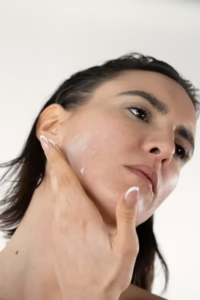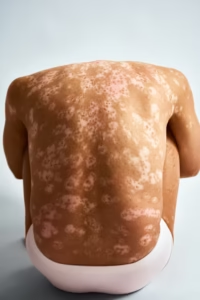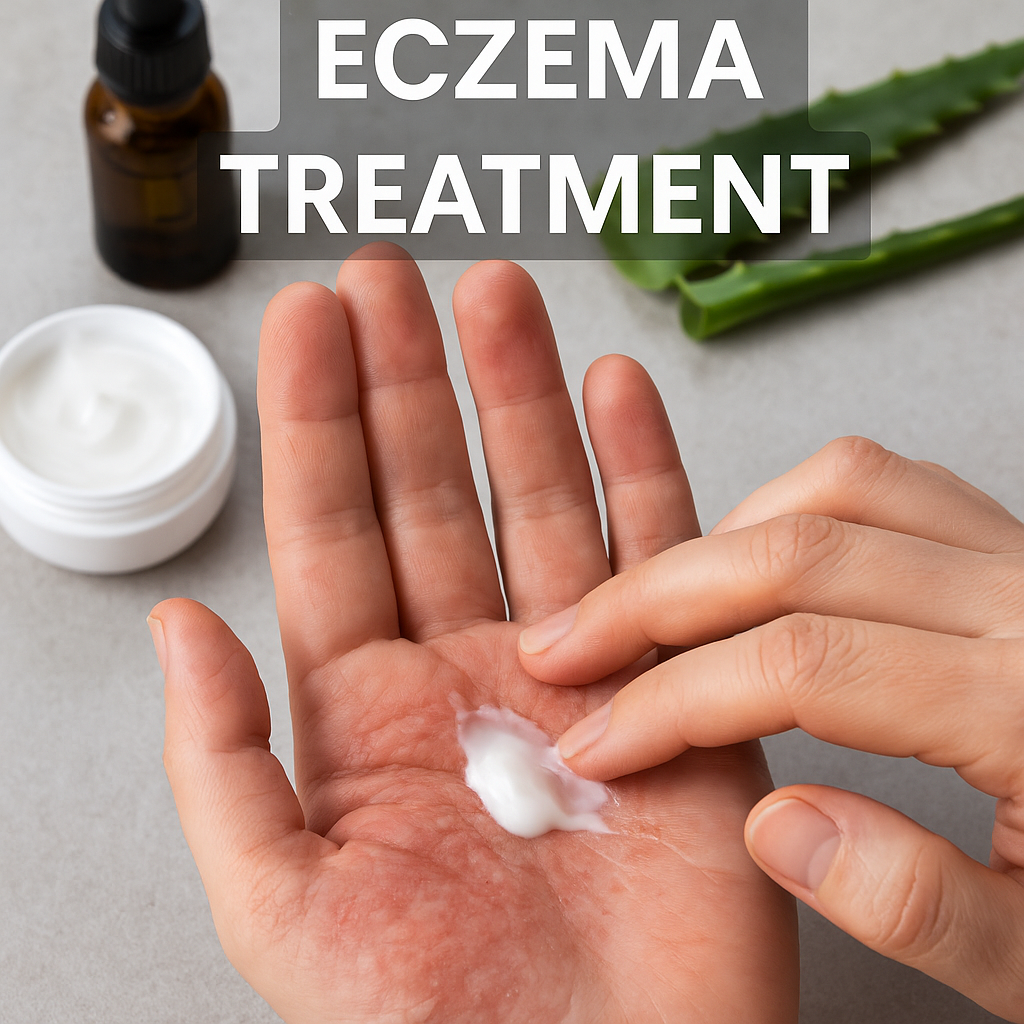Dyshidrotic eczema, also known as pompholyx or dyshidrosis, is a type of eczema that causes small, intensely itchy blisters on the edges of the fingers, toes, palms, and soles of the feet. This condition can be frustrating, painful, and persistent, often flaring up without warning. While the exact cause is not fully understood, the good news is that there are several effective treatments and management strategies to help soothe the symptoms, prevent flare-ups, and improve overall quality of life. Dyshidrotic eczema treatment
We’ll explore everything you need to know about dyshidrotic eczema treatment—from the basics of the condition, its triggers, to both conventional and natural remedies that can help you regain control over your skin.
Understanding Dyshidrotic Eczema
What Is Dyshidrotic Eczema?
Dyshidrotic eczema is a chronic skin condition that causes the formation of tiny, fluid-filled blisters primarily on the hands and feet. These blisters are often accompanied by intense itching, burning sensations, and inflammation. Over time, the skin may become dry, cracked, or scaly once the blisters heal, leading to discomfort and sometimes secondary infections. Dyshidrotic eczema treatment
Common Symptoms
Small, deep-set blisters on palms, fingers, soles, or toes
Intense itching and burning before blisters appear
Redness, swelling, and pain in affected areas
Dry, flaky, or cracked skin after blisters dry out
Thickening or discoloration of the skin with repeated flare-ups
What Causes Dyshidrotic Eczema?
There is no single known cause of dyshidrotic eczema, but a combination of genetic, environmental, and lifestyle factors can contribute to its development. Common triggers include:
1. Stress
Emotional or physical stress is one of the most common triggers of dyshidrotic eczema. Stress can affect the immune system, leading to inflammatory responses that manifest on the skin.
2. Allergens and Irritants
Exposure to certain metals (especially nickel and cobalt), fragrances, cleaning products, or detergents can trigger flare-ups. People working in cleaning, metal handling, hairdressing, or healthcare may be more prone due to frequent exposure to irritants.
3. Excess Moisture or Sweating
Hot and humid climates or excessive sweating (hyperhidrosis) can aggravate the condition. Wet hands and feet for extended periods also increase susceptibility.
4. Genetics and Atopic Background
Those with a personal or family history of atopic conditions like asthma, hay fever, or atopic dermatitis are more likely to develop dyshidrotic eczema.
5. Fungal or Bacterial Infections
Infections on the skin or in the body can either trigger or worsen dyshidrotic eczema. In some cases, treating an underlying fungal infection can reduce eczema flare-ups.
Conventional Treatments for Dyshidrotic Eczema
1. Topical Steroids
Corticosteroid creams and ointments are commonly prescribed to reduce inflammation and control itching. In more severe cases, a stronger prescription steroid may be necessary.
Mild cases: Hydrocortisone 1% (OTC)
Moderate to severe cases: Prescription steroids like clobetasol or betamethasone
It’s important to use steroids as directed and avoid long-term overuse due to side effects such as skin thinning.

2. Oral Medications
For more extensive or stubborn flare-ups, doctors may prescribe:
Oral corticosteroids (e.g., prednisone) for short-term use
Antihistamines to relieve itching
Immunosuppressants (e.g., methotrexate, cyclosporine) in severe chronic cases
3. Phototherapy (Light Therapy)
Phototherapy involves exposing the affected skin to ultraviolet (UV) light under medical supervision. This treatment helps reduce inflammation and slow down the immune response. It’s especially helpful for patients who do not respond well to topical or oral treatments.
4. Botox Injections
For those whose dyshidrotic eczema is triggered by excessive sweating, botulinum toxin (Botox) injections can help reduce sweating and subsequently prevent flare-ups.
5. Antibiotics or Antifungals
If secondary bacterial or fungal infections are present, appropriate antibiotics or antifungal medications will be necessary before eczema treatment can be effective.
Natural and Home Remedies for Dyshidrotic Eczema
While medical treatments are essential, natural and lifestyle remedies can support healing and prevent recurrences.
1. Soothing Soaks
Vinegar Soaks: Mix 1 part apple cider vinegar with 3 parts water and soak hands or feet for 10–15 minutes. This can help balance skin pH and reduce fungal activity.
Saltwater Soaks: Sea salt soaks can draw out moisture from blisters and provide relief from itching.
Oatmeal Baths: Colloidal oatmeal has anti-inflammatory properties that soothe irritated skin.
2. Cold Compresses
Applying a cool, damp cloth to the affected area can reduce inflammation and itching, especially during a flare-up.
3. Moisturizing Regularly
Dyshidrotic eczema dries out the skin severely. Use rich, fragrance-free moisturizers multiple times a day, especially after hand washing or bathing.
Recommended moisturizers:
Petroleum jelly
CeraVe Healing Ointment
Vanicream
Eucerin Advanced Repair Cream
4. Dietary Changes
While more research is needed, some individuals report improvement by eliminating or reducing:
Nickel-rich foods (e.g., nuts, chocolate, soy, oats)
Dairy and gluten
Processed or sugary foods
Adding anti-inflammatory foods like fatty fish, turmeric, and leafy greens may also help.
5. Herbal Remedies
Some people find relief using herbal creams or extracts, including:
Calendula: Known for its wound-healing properties
Aloe Vera Gel: Reduces inflammation and provides a cooling effect
Chamomile: Has soothing and anti-inflammatory effects
Lifestyle Modifications to Prevent Flare-Ups
1. Protect Your Hands and Feet
Wear gloves while washing dishes, gardening, or using cleaning products.
Avoid rubber or latex gloves if allergic—opt for cotton-lined alternatives.
Choose moisture-wicking socks and breathable footwear.
2. Avoid Long Exposure to Water
Repeated exposure to water can weaken the skin’s barrier. Limit soaking and keep showers short. Always moisturize afterward.
3. Manage Stress Effectively
Because stress is a major trigger, try incorporating stress-reducing practices such as:
Yoga
Meditation
Deep breathing exercise
Journaling or therapy
4. Choose Skin-Friendly Products
Use unscented, hypoallergenic soaps, laundry detergents, and skin products. Always test new products on a small area first.

When to See a Doctor
Although many mild cases of dyshidrotic eczema can be managed at home, seek medical advice if:
Blisters are very painful and spreading
The condition affects your ability to work or sleep
Home remedies and OTC treatments aren’t working
Signs of infection occur (redness, pus, swelling)
You’re unsure if it’s eczema or another condition (like fungal infection or psoriasis)
A dermatologist can help confirm the diagnosis and tailor a treatment plan for your unique needs.
Living with Dyshidrotic Eczema: Realistic Expectations
Dyshidrotic eczema tends to be chronic, with periods of flare-ups and remission. It’s important to set realistic expectations: while a permanent “cure” may not exist, it is possible to reduce the frequency and intensity of symptoms through diligent care and management.
With the right combination of medical treatment, lifestyle modifications, and supportive care, many people live comfortably and flare-free for long periods.
Conclusion
Dyshidrotic eczema can be a challenging and sometimes painful condition, but with the right approach, you can manage it effectively. The key lies in understanding your triggers, taking preventive measures, staying consistent with skincare routines, and seeking professional help when necessary.
Whether you prefer conventional medicine, natural remedies, or a blend of both, the most effective treatment is the one that works for your body and lifestyle. Remember, you’re not alone—and relief is possible with the right care.
FAQs About Dyshidrotic Eczema Treatment
Q1: Can dyshidrotic eczema be cured?
No permanent cure exists, but many people find lasting relief through consistent management and by avoiding triggers.
Q2: Is dyshidrotic eczema contagious?
No. It is not an infection and cannot be passed from person to person.
Q3: How long does a flare-up last?
Flare-ups typically last 2–4 weeks. Proper treatment can help speed up healing.
Q4: Can diet help?
Yes, for some individuals, dietary changes (like reducing nickel intake or cutting out processed foods) can make a noticeable difference.
Q5: Can children get dyshidrotic eczema?
It’s more common in adults between 20–40 years, but children can develop it, especially if there’s a family history of eczema or allergies.

